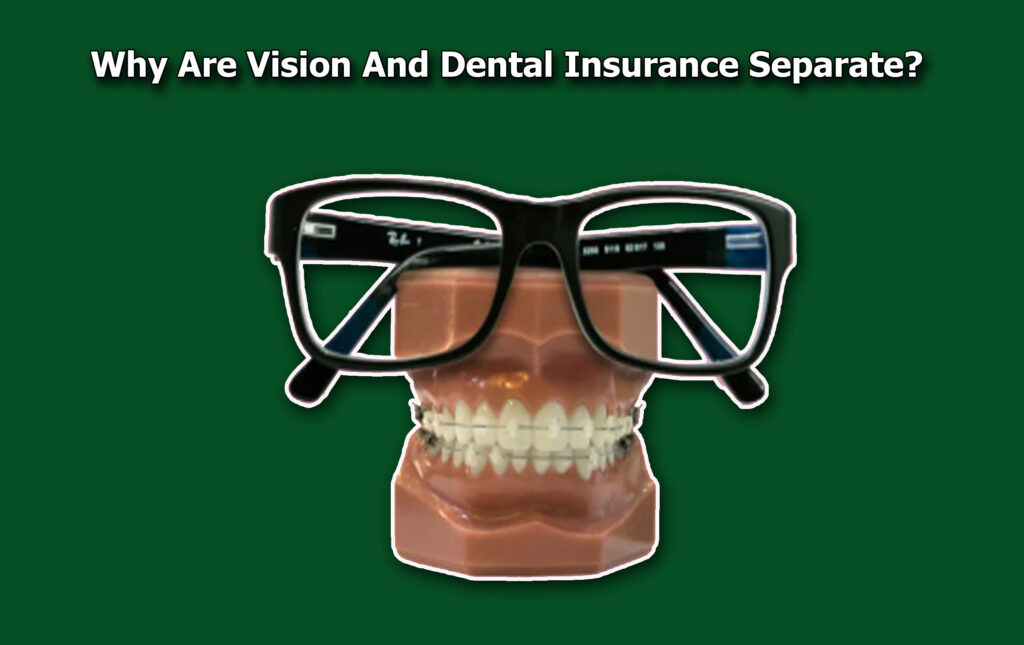Why are vision and dental insurance separate? The purpose of health insurance is to cover medical expenses related to a person’s overall well-being, including doctor visits, hospital stays, and emergency care.

However, when it comes to vision and dental care, these services are often covered under separate insurance plans.
Many people often question why these healthcare services are not included in standard medical insurance policies. However, the separation of vision and dental insurance has historical, economic, and practical reasons that continue to influence how these services are covered today.
Furthermore, the exclusion of vision and dental care from traditional health insurance is mainly because of how these fields developed in the healthcare industry.
Historical Reasons For The Separation
The division between the dental and vision care actually dates back several decades, and it is rooted in the way these medical fields developed.
Unlike general medical care, which covers a wide range of conditions. Dental and vision care were historically considered specialized areas with unique treatment approaches. Let’s look at some of the reasons:
- Independent Medical Professions: Firstly, dentistry and optometry evolved separately from general medicine, with their own specific schools, licensing requirements, and professional organizations.
- Different Treatment Models: Also, the general healthcare focuses heavily on treating acute and chronic illnesses. On the other hand, dental and vision care emphasize routine preventive maintenance, such as cleanings and eye exams.
Because of these historical divisions, insurance companies built separate policies for dental and vision care, which have continued to exist as standalone coverage options to this day.
Risk Assessment And Cost Structures In Insurance
While health insurance is designed based on risk assessment. Dental and vision insurance operate under a different risk model than general medical insurance.. Let’s look at the risk assessment and other contributing factors:
- Lower Financial Risk: Medical insurance covers unpredictable, high-cost emergencies like surgeries and hospitalizations. However, dental and vision care are more predictable, with routine checkups and planned treatments like fillings or eyeglasses.
- Preventive Focus: Most dental and vision issues can be managed through regular maintenance, which makes their cost structure different from unpredictable medical expenses.
- Limited Coverage Needs: Unlike medical insurance, which covers severe diseases and injuries, dental and vision insurance primarily covers examinations, minor procedures, and corrective lenses.
Since these differences make dental and vision insurance easier to manage separately. Insurance providers structure them as independent plans with lower premiums but limited coverage compared to general health insurance.
Employer And Insurance Industry Influence
Employers play a significant role in determining how health benefits are offered to employees. And this has contributed to the continued separation of dental and vision insurance.
- Employee Benefit Customization: Companies often choose to provide basic health insurance while offering dental and vision as optional add-ons to manage costs.
- Cost Control for Employers: Separating these plans allows businesses to control expenses by selecting only the coverage options they can afford.
- Insurance Industry Profitability: By selling dental and vision insurance separately, insurance companies generate additional revenue through standalone policies and supplementary plans.
Since most employers structure benefits this way, the separation of dental and vision coverage remains a standard practice in the insurance market.
Would Including Vision And Dental With Health Insurance Be Beneficial?
Many argue that including the vision and dental insurance with general health coverage could be beneficial for consumers. As it could reduce the financial burden and improving overall healthcare accessibility. However, there are both advantages and setbacks to this approach.
Potential Advantages
- Combining all medical, dental, and vision services under one plan would create a more unified approach to healthcare.
- Also, consumers might save money if dental and vision expenses were included in their primary health insurance plans.
- With better coverage, more people could afford regular dental cleanings and eye exams, reducing long-term health risks.
Setbacks One May Face
- Adding dental and vision care to standard health insurance policies would likely increase overall premium costs.
- Insurance companies would need to restructure their policies, which could result in challenges and delays.
- Since dental and vision care involve routine checkups rather than high-risk medical conditions. Insurers might then struggle to balance the cost-risk ratio effectively.
While this move has potential benefits, the financial and structural complexities involved make it unlikely that vision and dental insurance will become part of standard health insurance in the near future.
Frequently Asked Questions
Why Aren’t Dental And Vision Included In Regular Health Insurance?
Dental and vision care evolved separately from general medicine, which led to different treatment models, insurance structures, and risk assessments. This historical separation has continued due to financial and administrative factors.
Does Any Health Insurance Plans Cover Vision And Dental?
Some comprehensive health plans, such as those under Medicaid or certain employer-sponsored benefits, include limited dental and vision coverage. However, most private health insurance plans require separate policies for these services.
Is It Cheaper To Buy Dental And Vision Insurance Separately?
Yes, standalone dental and vision plans tend to have lower premiums, but they may also have limited coverage. What’s more, bundling them with a health insurance policy could sometimes save more cost.



